Female paddlers shopping for their first, or next, kayak can be forgiven for wondering where all the women’s models are. Nearly every outdoor pursuit—think biking, backpacking, skiing and even snowshoeing—now has gear made exclusively for women. Is the kayaking industry trailing behind, or are we simply onto a different approach?
The answer lies in understanding the subtle distinction between “best kayaks for women” and “best women’s kayaks.” Search for the latter and you’re likely to come up empty-handed. But ask for the former, and a knowledgeable dealer can guide you toward a range of superb options focusing more on finding a perfect fit than a pretty color palette.
Rather than focusing on gender-specific marketing, or designing one or two boats just for women, the kayaking industry has adopted the approach of different-sized kayaks for different-sized people. Most manufacturers now offer multiple size options across a wide variety of models, from expedition and fitness kayaks to those built for recreational use, fishing and light touring.
Go shopping for a kayak today and you’ll discover thoughtful designs fitting both sexes and all sizes. There’s truly a kayak for everyone—here’s how to find yours.
Shop Women’s Kayaks
Different types of women’s kayaks suit different destinations and types of kayaking. Whether you are looking to pack your camping kit for an overnight tour, explore a local waterway with friends or paddle for fitness, there are kayaks designed for women to meet your needs.
Top picks: Best Women’s Kayaks for 2025
The following women’s kayaks have received the highest star ratings by reviewers in our Paddling Buyer’s Guide.
Best Kayaks for Women

Mirage Outback
-first_product_boats.jpg)
BKC TK122 Angler Tandem Coastal Cruiser Kayak

BKC FK285 Sit-On-Top Angler Solo Kayak
Shopping for a Used Women’s Kayak?
With patience, attentiveness and a little bit of research, you can find a used women’s kayak that will outperform many new kayaks for a fraction of the price. Used kayaks designed for women are sold both privately and through dealers or outfitters.
Used women’s kayaks will mostly be found in online classifieds like Craigslist, Facebook Marketplace or Kijiji. If there are particular makes, models or sizes you know you would prefer, setting an email alert is a handy way to be notified as soon as they become available.
One now-discontinued model of particular note is the Necky Eliza. Fifteen or so years ago, the Necky Eliza pioneered women’s specific design. Since Necky ceased production in 2017, the only Elizas you’re likely to find now will be on the used market.
Another avenue for scoring a great deal on a used women’s kayak is through an outfitter. Outfitters often have end-of-season sales of their rental fleets, and some may even take offers on any boats they have. Renting the boat for a day or an overnight trip is a great way to test-paddle the kayak before buying it. The guides and staff at the shop will be familiar with the boat’s best uses and can help you decide if it will suit your personal needs. If your used kayak needs any new parts, they may also be able to order them.
For more tips on what to look for when selecting a used kayak, read our article How To Buy A Used Kayak.
Buying Advice
The first question that needs to be answered when shopping for a women’s kayak is: what is a women’s kayak?
What is a women’s kayak?
The short answer is, it depends who you ask. In the past, sizing a kayak for an average-sized woman or smaller man meant keeping the same hull and simply lowering the deck and fitting a smaller cockpit.
That isn’t to say there’s never been a kayak aimed squarely at women. As mentioned above, 15 or so years ago, the Necky Eliza pioneered women’s specific design with scaled down proportions to suit smaller, lighter paddlers with narrower shoulders and a lower center of gravity. The designers even consulted a female physician paddler to dial in cockpit ergonomics. With their lighter weight and playful handling, both plastic and composite versions of the boat were hugely successful. So what happened?
Perhaps the Eliza was simply ahead of her time. Necky’s notion of “fitting the boat to the paddler” flew in the face of popular wisdom that longer equals faster, period. The Eliza demonstrated the fastest boat for you is one that a) fits properly and b) has the least possible drag at the speed you normally paddle.
Fast-forward to today’s market. Rather than focus on gender-specific marketing and design, the kayaking industry has adopted the approach of different-sized kayaks for different-sized people. The tremendous range of kayak sizes means there’s no need to brand some models as women’s specific, argues Graham Ketcheson, marketing director for Kayak Distribution, which produces Boréal Design kayaks.
“Smaller people regardless of gender tend to choose a kayak that is smaller, fits them better, and is made of lighter weight material so they can carry and lift it on and off their vehicles,” Ketcheson says. “Larger people choose more voluminous kayaks… I think it can be that simple.”
Dale Williams, a longtime U.S. distributor for Sea Kayaking UK (Nigel Dennis Kayaks) and internationally recognized sea kayaking coach, puts it another way.
“There is such a thing as a kayak designed to optimize certain physical characteristics that are more common among women,” Williams says. “That doesn’t mean these designs would not also work for many men, or that kayaks designed without these objectives in mind might not still work for many women.”
Johnson Outdoors, which ceased production of Necky Kayaks in 2017, still produces a pair of women’s recreational kayaks under its Ocean Kayak brand. The Venus 10 and Venus 11 are sit-on-top kayaks with female-friendly features like a higher seat position, narrower width, lighter weight, and added carry handles for easier lifting and cartopping.
Getting started
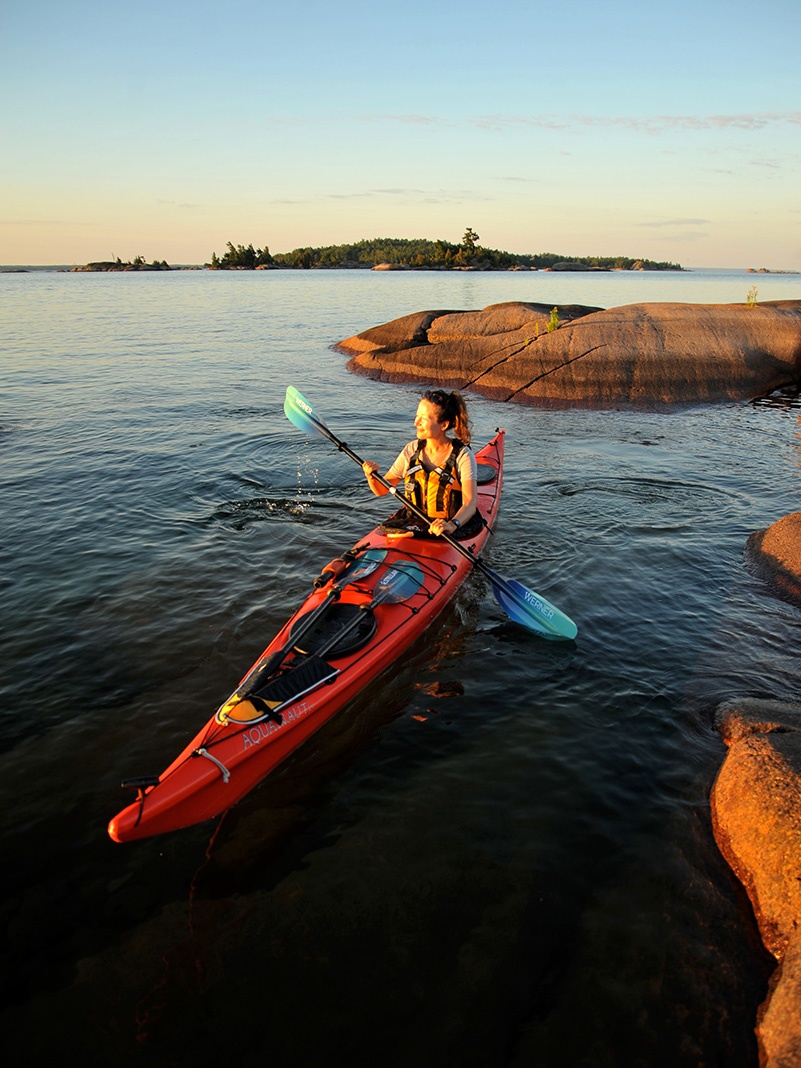
Everyone’s adventures look different. Understanding the type of paddling you want to do is the first step to finding the best women’s kayak for your needs.
The touring kayak market includes everything from 17-foot expedition sea kayaks for those looking to take long wilderness trips, to a wide range of shorter 13- to 15-foot boats for weekend trips on all types of waterways. Known as light touring or day touring kayaks, these smaller boats offer paddlers a lighter, more compact option that is easier to store and transport, and maybe take out on an overnight trip. Recreational women’s kayaks in the 10- to 12-foot range are ideal for casual users and grab-and-go day trips on calmer waters.
Enthusiasts can also find more specialized women’s kayaks for fitness paddling, ocean play, whitewater, fishing, rolling and more.
How well a kayak fits is the single most important factor in how much you will enjoy paddling it. This is especially true for smaller paddlers who fall outside the traditional kayak sizing paradigm.
Most manufacturers now offer a rough size guide with suggested weight ranges for each model. If you’re starting your search online, Mike Patterson, U.S. director of operations for Pyranha and P&H Kayaks, suggests, “Narrow down the hull type you prefer, then look at weight ranges, widths and outfitting adjustability, in that order.”
In the store, put your feet on the foot pegs and your legs under the thigh braces. You should feel comfortable, yet engaged. If the kayak is too tight, you risk being cramped or unstable. If it’s too loose, you will have a hard time engaging your lower body and controlling the boat. Rock back and forth using your hips and determine which size kayak feels the most comfortable. If you’re on the smaller side, look for sizes marked with “LV” for low volume.
The best kayak for women is the one that fits. If none of the sizes feel right, try a different model. A kayak that fits you well will give you more stability and control than a boat that is too tight or too loose.
Ultimately, experts agree, the only way to know for sure whether a kayak is right for you, is to get in it and go for a paddle. Buy from dealers that offer this opportunity (or a great return policy), and try as many styles as you can before committing to a purchase.
Types
There are as many types of kayaks suited to women as there are styles of kayaking. Before you zero in on important factors like size, fit, features and color preference, you’ll need to identify why and where you’ll kayak most often.
These are the most popular types of kayaks for women, and the environments to which they’re best suited:
Recreational Kayaks
Recreational kayaks for women are all about ease of use and value. Whether they are sit-inside or sit-on-top designs, recreational kayaks put a premium on stability. They aren’t as fast as touring kayaks, but they feel more secure on the calm, sheltered waters for which they are designed.
Recreational kayaks often offer very basic features and come at an affordable price. In some cases they are just a simple kayak hull with a seat and little else. Better designs incorporate some touring kayak features, like hatches and bulkheads for dry storage and deck bungees for stashing a water bottle. If you plan on paddling farther from shore, choose a sit-on-top recreational kayak that can be easily reentered if you fall out. Most sit-inside recreational kayaks should only be used close to a shoreline with easy landings and minimal exposure to wind and waves, since they lack adequate flotation when swamped and can be difficult to reenter from deep water.
Recreational kayaks come in a wide range of lengths and designs. Few are shorter than nine feet and most are no longer than 13 feet. All are wider than touring designs of similar length.
Women considering a recreational kayak should take a look at designs around 10 to 12 feet long and less than 25 inches wide for a sit-inside, or less than 30 inches wide for a sit-on-top. Boats shorter than this may be lighter and less expensive, but noticeably slower. Those that are wider will be heavier and smaller paddlers will find they feel sluggish and slow to respond.
Ocean Kayak produces a pair of recreational kayaks for small women and mid-sized paddlers. The Venus 10 and Venus 11 are women’s sit-on-top kayaks with female-friendly features like a higher seat position, narrower width, lighter weight and added carry handles for easier lifting and cartopping.
Touring Kayaks
Touring kayaks for women are sleek and fast sit-inside kayaks designed for long-distance travel and camping. Common styles of touring kayaks include day touring (or light touring) kayaks and sea kayaks, which range in length from around 13 to 15 feet and 16 to 17 feet, respectively.
Most touring kayaks are fitted with bulkheads and hatches front and rear for dry storage and flotation, making them suitable for trips on more exposed and challenging waters. Many have rudders or retractable skegs to help control direction in wind. Safety features like a continuous deckline running around the perimeter of the kayak are common.
While the average width of a touring kayak is around 22 to 24 inches, touring kayaks designed for women are typically narrower. The wider the boat, the more stable, but also slower, it will be. Since women, on average, have a lower center of gravity, they have less need for speed-sucking stability and can feel comfortable in a sleeker women’s sea kayak.
Day touring kayaks are excellent for aspiring paddlers who want to develop their skills but have no intentions of taking overnight and multiday trips. Day touring kayaks are lighter, more compact and easier to secure on a car’s roof rack than full-sized sea kayaks.
Sea kayaks are often expertly designed for specific applications, such as overnight kayak camping trips or rough water paddling. Take a close look at a women’s sea kayak if you want to develop your skills, explore exposed coastlines and undertake multiday camping trips.
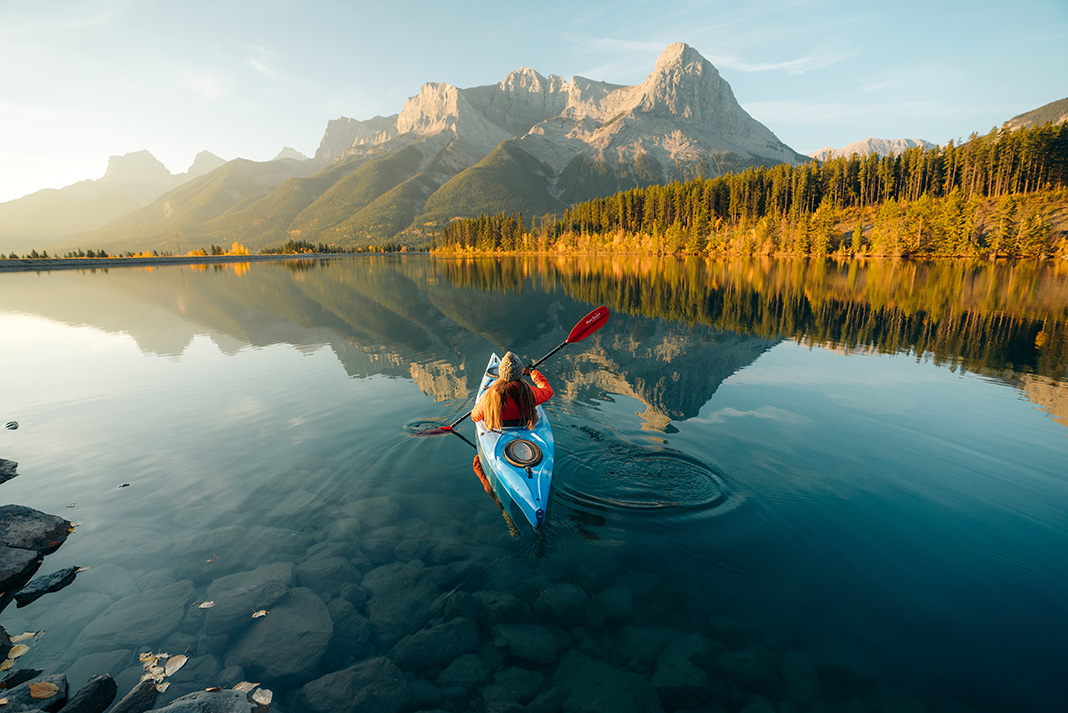
Fishing Kayaks
Fishing kayaks are specialized recreational designs suited to avid kayak anglers. In fact, many of the most popular fishing kayaks are simply recreational kayaks with certain upgrades to on-board accessories and outfitting—like rod holders, livewells and convenient places to store tackle, fish finders and other gear. Most women’s fishing kayaks are sit-on-top designs, which allows for good mobility, ease of landing fish and safety when far from shore.
Some fishing kayaks are wide enough for standing. These designs are typically slower, but their wider beams provide ample stability for sight casting and fighting fish. An added benefit of wider designs is that seats can be mounted higher for more effective sighting and casting.
Pedal drive fishing kayaks are another popular option, allowing a kayak angler to keep her hands free for managing tackle, casting and handling fish. There are a variety of pedal kayak propulsion systems, including those with fins and others with propellers. Since there are no dedicated women’s fishing kayak pedal drives yet, it is especially important for women to try out these kayaks before buying. Ocean Kayak and Old Town brand manager, Julia Winske, urges women to visit their local shop and try using the pedal drive to make sure the ergonomics work for them.
In colder climates, some kayak anglers prefer closed cockpit fishing kayak designs. These kayaks offer less flexibility for fish wrangling, but provide more protection from cold water and air temperatures.
Whitewater Kayaks
Whitewater kayaks are specialized designs for running river rapids. Most whitewater kayaks are sit-inside designs with smaller cockpits that can be sealed tightly with a neoprene sprayskirt. They are the most maneuverable kayaks with hulls that are short and rockered (shaped like a banana) to turn on a dime. Some models also feature a flat surface on the hull that planes on a wave like a surfboard, allowing the paddler to perform tricks on river features like recirculating holes and standing waves.
Whitewater kayaks come in a variety of styles, depending on their intended use. River runners are whitewater kayaks intended for covering miles and playing on river features along the way. River runners are usually longer than playboats and creek boats and faster than either on the water.
Playboats are about fun on the water—surfing waves and performing tricks like cartwheels and squirts. They’ll almost always have a planing hull for precise surfing. If you decide to choose a playboat instead of a river runner, remember you’ll be trading plush comfort for play in most cases. Freestyle kayaks are a more specialized version of playboats. Like playboats, freestyle kayaks won’t offer the most comfort for a long day on the water, but they will unlock the potential of any play spot on the river.
Creek boats are designed to make running very steep whitewater safer and easier. You probably already know if you need a creek boat. Women who are comfortable on class III and are interested in challenging themselves on harder water often choose a creek boat to make class IV more accessible and fun.
For women looking to develop the skills to paddle whitewater rivers, the right kayak choice is critical. “User-friendliness is key,” says Emily Jackson, freestyle kayak champion, designer and whitewater brand manager for Jackson Kayak. “Look for comfort, durability and light weight—those three things can make a big difference in your paddling growth.”
Materials
Kayaks are constructed from various materials, including plastic, fiberglass, carbon, wood and vinyl or other materials for a folding or inflatable kayak. Each material has benefits and drawbacks, relating to price, performance and durability.
Plastic kayaks dominate the recreational, day touring, fishing and whitewater markets, with rotomolded polyethylene being the most common material. Rotomolded kayaks are durable and particularly impact-resistant, which is why nearly all whitewater boats are rotomolded. Rotomolding can be used to create an almost infinite range of kayak designs. The toughness of the material makes it a good choice for many paddlers, as does its modest cost.
The biggest downside of rotomolded kayaks is they tend to be heavier than boats made from other materials. If you are looking for light kayaks for women, there are better material options. Rotomolded boats are also a little more flexible than composite designs, so the material isn’t quite as good for high-performance designs like racing kayaks and sea kayaks.
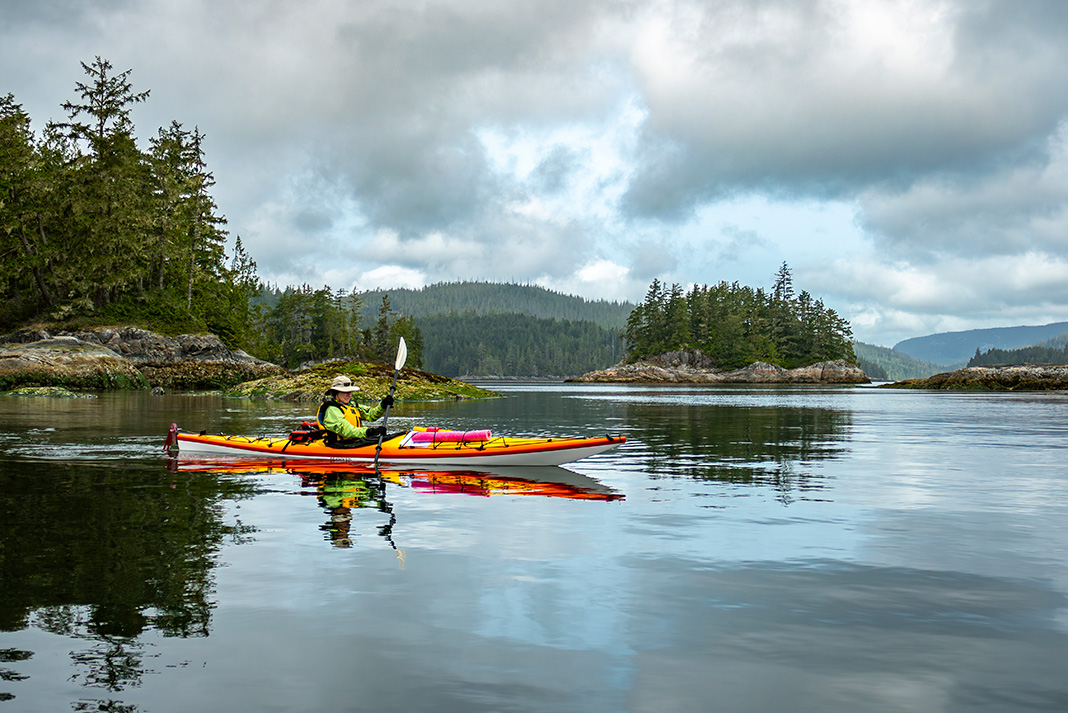
Composite kayaks are made from layers of fiberglass or aramid cloth laminated together with resin. In general, composite kayaks are lighter and stiffer than rotomolded designs. This makes composite a good choice for longer touring kayaks or high-performance racing and fitness designs.
If you are searching for ultralight touring kayaks for senior women to ease the transition from roof rack to put-in, carbon kayaks offer the absolute lightest (and most expensive) option. However, unless they are reinforced with additional layers of gelcoat or a keel-strip, they are not as durable as fiberglass. This is fine if you are paddling in calm conditions, but if you plan on dragging the kayak up a pebble beach it won’t last long.
Thermoformed kayaks fill a middle ground between rotomolded designs and composites. They cost more than rotomolded boats but less than composites, and they’re roughly in between the two materials in terms of stiffness and impact resistance. Many light touring and touring designs are built in this material and offer excellent value. Thermoformed kayaks are a great option if you’re seeking out light kayaks for women at a budget-friendly price.
Wooden kayaks are not as common, but their owners love their classic look and warm aesthetic. They can be designed with high-performance shapes, and the characteristics of wood give them a unique feel in the water. Many of these touring and recreational designs are made with do-it-yourself kits, and half the fun is the project of building the boat. Wooden kayaks are lightweight and beautiful, making them a wonderful option for women who have the time, tools and desire to build their own boat.
Folding kayaks or inflatable vinyl designs prioritize portability. These kayaks store into duffels and are assembled at the put-in. They’re ideal for women who are tight on space, like those living in condos, or for airline travel to exotic destinations. Generally, these kayaks have the advantage of portability at the expense of performance. Look to established companies for folding and inflatable kayaks with better quality and performance.
Design Features
Building the best kayaks for women means getting more women involved in kayak development and design. Happily, the number of female product developers, team paddlers and design influencers is growing.
At Johnson Outdoors, makers of Old Town and Ocean Kayak, women hold key positions across all aspects of the design process, “from consumer insights and industrial design, to production and everything in between,” says Julia Winske.
Sea Kayaking UK (Nigel Dennis Kayaks) made great leaps forward in designs suiting women when advanced-level sea kayak coach and expedition leader, Eila Wilkinson, became involved in their design process. Wilkinson wanted narrower, faster boats that were rough water capable and more responsive to smaller paddlers. Her input led to the design of NDK’s Pilgrim, Pilgrim Expedition and Echo kayaks, which are favorites of diminutive women—and men—around the world.
Progress isn’t limited to touring and recreational kayaking. At Jackson Kayak, women are integral to the design teams for both whitewater and fishing kayaks—two segments traditionally dominated by men.
“We have a wide variety of influences and team paddlers including women, men, kids, teens and individuals with disabilities,” says Emily Jackson. “By casting this wide net, we look for common threads and get as close as we can to the needs of every style and shape of kayaker.”
When it comes to feedback from women paddlers, concerns around weight, comfort and speed are top of the list. So too, is frustration at kayaks that feel heavy and sluggish.
“You could be doing all the right things, but not have the boat respond because it’s too big for you,” says Jackson.
Kayak weight is important for two reasons: a heavy kayak feels less nimble on the water and is slower to accelerate and harder to keep moving at a steady pace; and a heavy kayak is harder to lift and carry. This can make a big difference in how easy it is to get to and from the launch. Women who want the independence of lifting their kayak on and off a roof rack or trailer by themselves can seek out lighter composite and thermoformed materials to save on weight.
The size of a kayak also plays into its weight. But internationally recognized sea kayaking coach and NDK distributor, Dale Williams, says there’s another reason women should seek out narrower and shorter kayaks: speed.
“The wider the boat, the more stable,” he starts. “But why suffer a wider, slower boat when you’re plenty stable with a narrower, faster one?”
Unlike their typically more top-heavy counterparts, women, on average, have a lower center of gravity and less need for speed-sucking stability. Furthermore, wider boats create more surface area for wind and waves to push them around. All else being equal, says Williams, “The kayak the average man would find stable and controllable, the average woman will find slow and cumbersome.”
A narrower boat is also better suited to most women’s shoulder widths, allowing for an efficient, comfortable forward stroke and easier rolling.
The average woman also has less upper body strength than the average male paddler. It’s for this reason Williams recommends a correspondingly shorter kayak for many women.
Popular wisdom holds that longer equals faster, period. The best kayaks for women acknowledge that this is an oversimplification. The fastest boat for you is one that, a) fits properly, and b) has the least possible drag at the speed you normally paddle.
“Longer boats are only faster when you add more power,” Williams explains. “It’s why ‘getting her a longer boat’ has rarely been the answer for helping mixed sex couples paddle together at the same speed.”
If maximum speed is your objective, a paddler with lower center of gravity and less power can afford to go longer by also going narrower. Williams says this is the design rationale behind NDK’s Echo, at 16 feet, 10 inches long and a trim 19 inches wide.
Ultimately, choosing the best kayak for your needs still means identifying where you paddle most often, then getting on the water in as many models as you can to dial in the perfect fit. Be wary of sales pitches claiming one boat can do it all. No design excels in all types of water, just as there’s no such thing as “one size fits all.”
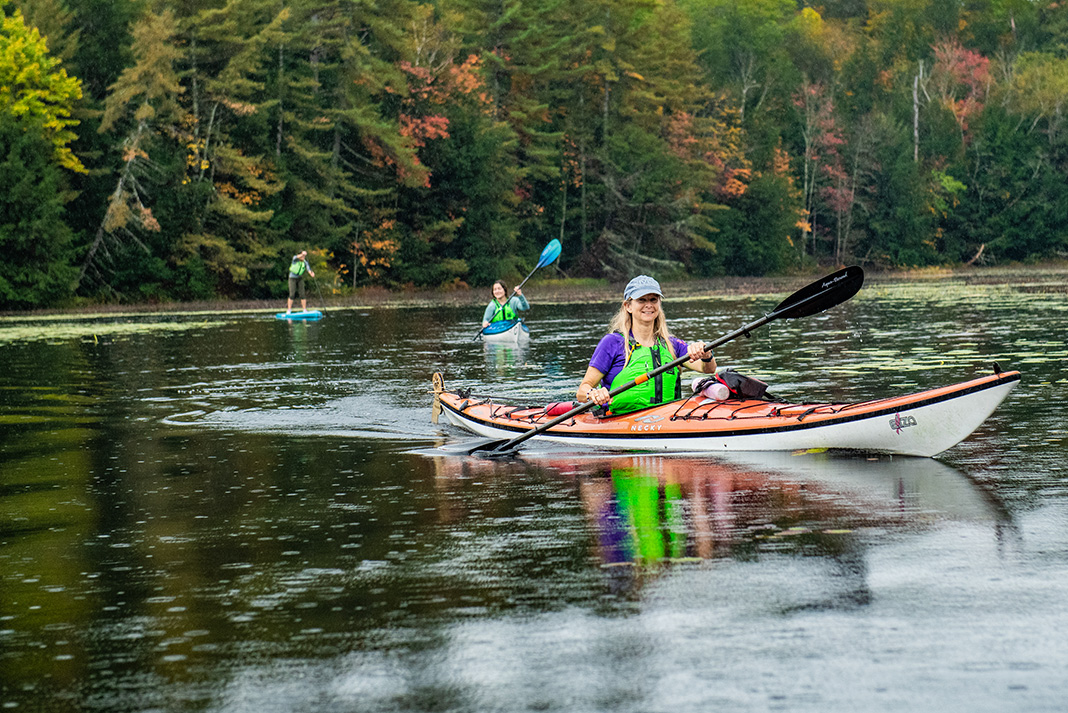
Outfitting
Outfitting describes the parts of the kayak that directly connect paddler to boat: the seat, back support, hip pads, thigh braces and foot pegs or pedals. Not surprisingly, outfitting plays a critical role in ensuring a good fit and enhancing on-water comfort and control.
Emily Jackson says conscientious outfitting can solve the most common feedback she hears from other women paddlers. “They want to feel more connected to their boat,” she explains. Whether you are looking at kayaks for small women or kayaks for heavy women, the best outfitting can be easily adjusted or customized to improve fit for every size and shape.
Starting with the seat, a woman’s lower center of gravity and often shorter reach calls for a higher seat position. “If you want to make a bigger boat feel more manageable, lift your seat,” says Jackson. Boosting the seat enables the paddler to transfer more power to their strokes and provides an easier reach over the cockpit rim and sidewalls.
While some kayaks may offer an adjustable height seat, you can also customize most kayak seats by adding a cushion or placing foam under the seat pan or liner. Kayaks with a seat that can be moved fore and aft also allow paddlers to trim the boat so it is optimally balanced for their height and weight.
In sit-inside kayaks, the hip pads and thigh grips work with the seat and backband to provide a snug yet comfortable fit. For many women, particularly those with curvier figures, this is a spot requiring special attention. Removable or adjustable hip pads and thigh braces allow paddlers to strike a balance between comfortable seating and a narrower performance fit. DIY types can also shape custom pads from blocks of closed cell foam.
The shape and size of the cockpit will also affect how a kayak fits, and how easy it is to get in and out of the boat. While large, open cockpits are standard on recreational kayaks intended for use in sheltered waters, paddlers touring on more exposed waters are better matched to a smaller oval or keyhole cockpit.
Oval-shaped cockpits vary in size, with some feeling too large for petite paddlers. Keyhole cockpits narrow toward the bow, allowing shorter legs to extend comfortably beneath the deck for a snugger fit. A shorter keyhole cockpit also makes it easier for smaller paddlers to secure or pull their spraydeck. Working with NDK to design their Pilgrim and Echo kayaks, Eila Wilkinson insisted on a shorter cockpit opening for another reason: so she could reach her chart on her front deck.
In addition to kayak ergonomics, a properly fitted PFD and lightweight paddle is key, says Julia Winske. Most life jacket manufacturers offer women’s specific paddling PFDs that are designed to fit a woman’s body by eliminating bulk around the bust. Paddles are sized based on your height and the width of your kayak, meaning women who go with a narrower boat should also choose a shorter paddle.
Price
Ask five people, “How much is a women’s kayak?” and you will get five different answers. Recreational kayaks are the cheapest option, starting from around $300 for a box store kayak, to around $800 to $1,500 for a recreational kayak from a well-known manufacturer. Generally speaking, you get what you pay for in terms of quality, comfort and performance.
Whitewater kayaks average $1,200 to $2,000. Fishing kayaks can vary tremendously in price, from sub-$1,000 recreational models to $5,000-plus pedal kayaks with all the bells and whistles.
Depending on the material, model and condition, a touring kayak will cost anywhere from $1,000 to $4,500. With an increase in price, there will often be an increase in quality, but that does not mean the most expensive kayak is the best for you. Consider your desired use and overall kayaking equipment needs. A good paddle and comfortable PFD will make a huge difference when using your kayak, so consider splurging in those areas instead of blowing your whole budget on a boat.
Where To Buy
Touring, recreational, whitewater and fishing kayaks are available at most local paddlesports retailers and national outdoor chains such as MEC or REI. Outfitters often have used kayaks for sale at the end of the season. Scouring online classifieds such as Kijiji or Facebook Marketplace can yield great deals on used women’s kayaks for those with time and patience.
Women’s Kayak Reviews
Researching the best kayaks for women doesn’t need to be daunting. From more diverse consumer research and more inclusive sizing, to involving more women in product development and design, kayak manufacturers are striving to make the paddling community a welcoming environment for all. These reviews from our experts across the women’s kayak spectrum will help you find one that will match your needs. Read these reviews through the lens of your own experience. Do you relate to the writer? Do the trips they took match what you are looking to do?
- Boat Review: Nigel Dennis Pilgrim Expedition Kayak
- Boat Review: The Easky 15 By Venture Kayaks
- Boat Review: The Pakesso by Boreal Design
Rather than looking for a “women’s kayak,” look for a kayak with particular features better fitting the physical characteristics more common among females. | Feature photo: Ron Watts


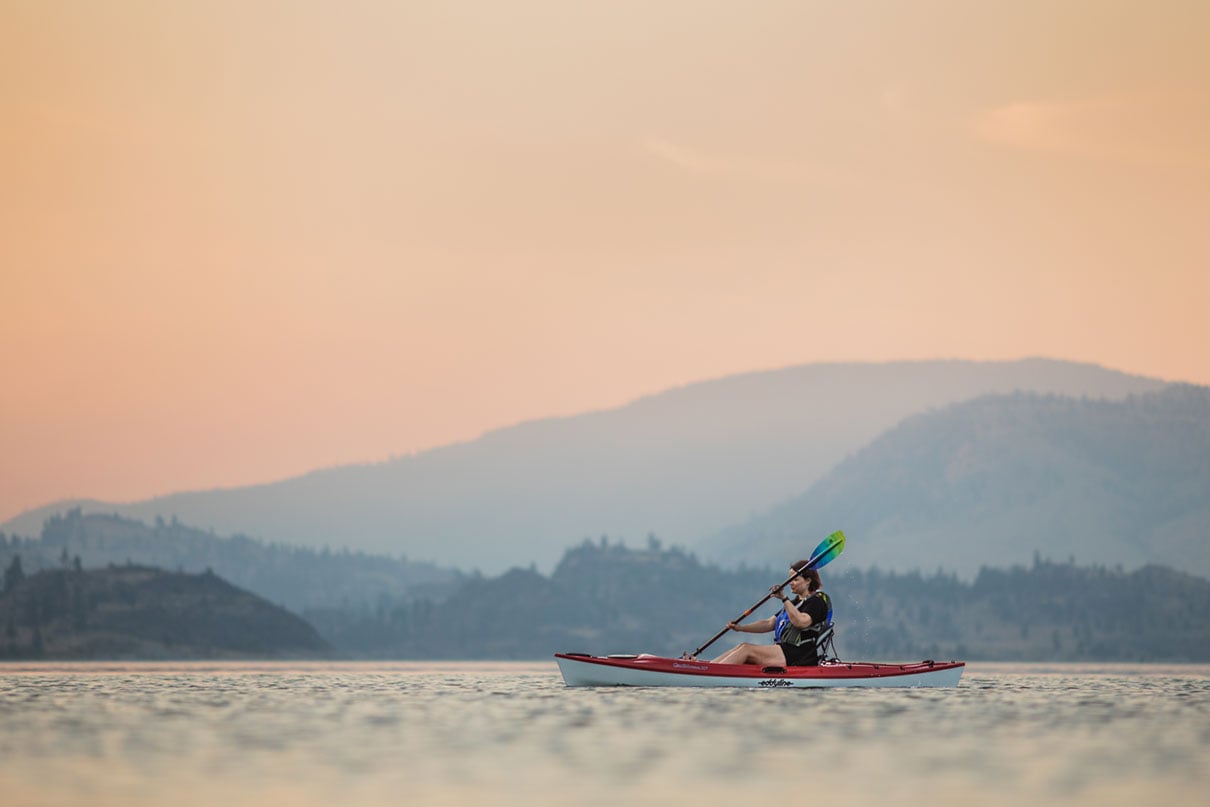



-first_product_boats.jpg)


-first_product_boats.jpg)
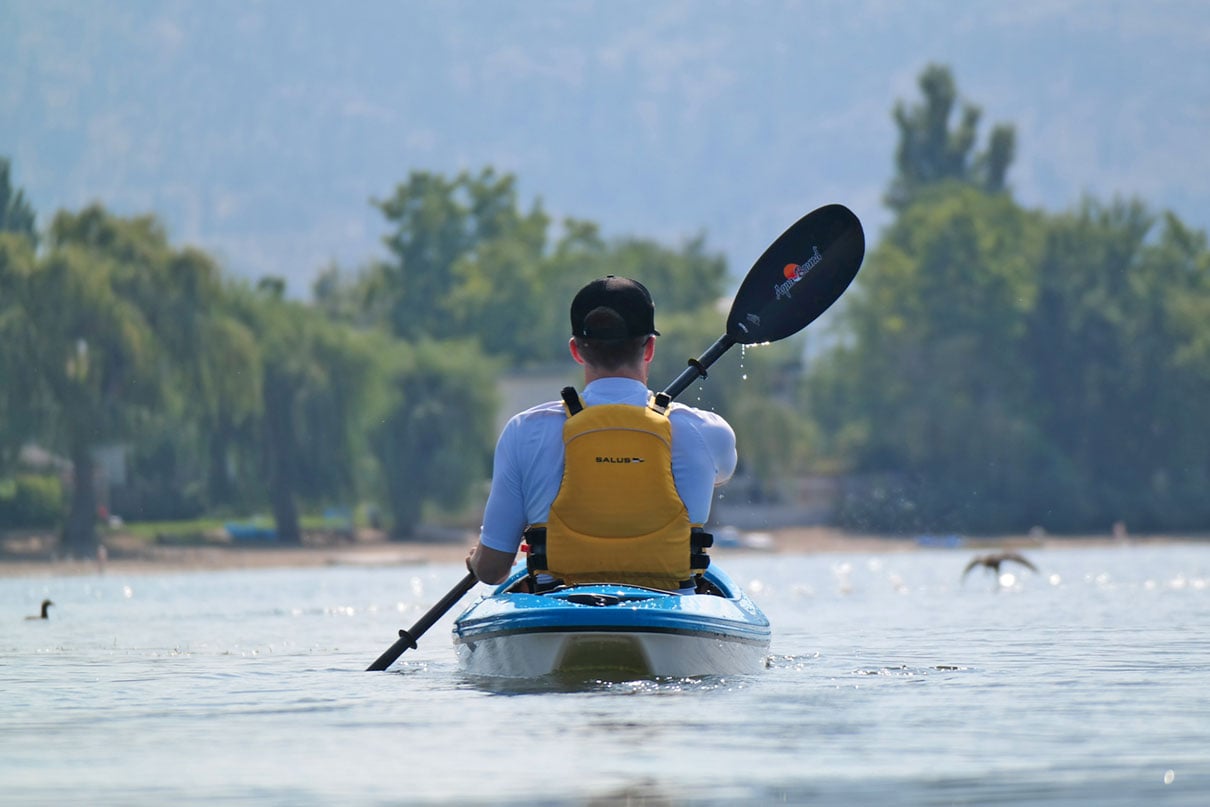
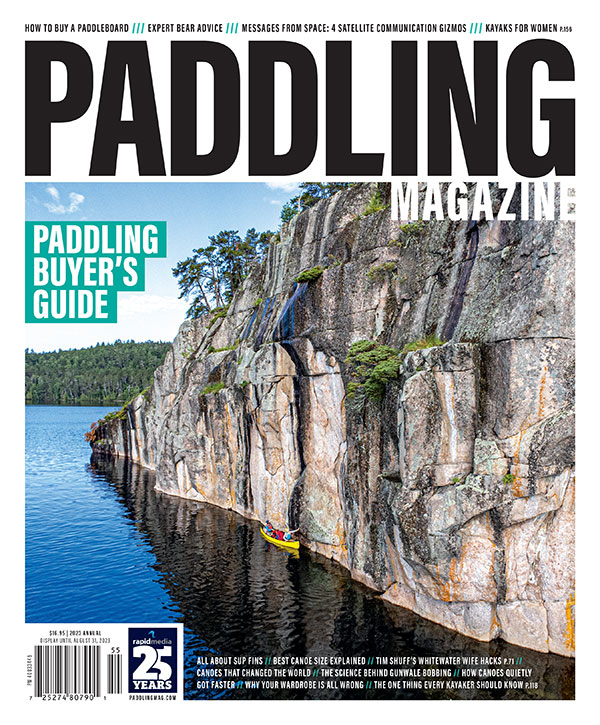 This article was first published in the 2023 Paddling Buyer’s Guide.
This article was first published in the 2023 Paddling Buyer’s Guide.